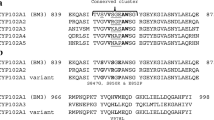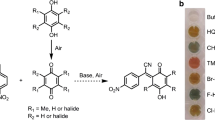Abstract
Cytochrome P450 BM-3 from Bacillus megaterium is a fatty acid hydroxylase exhibiting selectivity for long-chain substrates (12–20 carbons). Replacement of Phe87 in P450 BM-3 by Val (F87V) greatly increased its activity towards a variety of aromatic and phenolic compounds. The apparent initial reaction rates of F87V as to benzothiophene, indan, 2,6-dichlorophenol, and 2-(benzyloxy)phenol were 227, 204, 129, and 385 nmol min−1 nmol−1 P450, which are 220-, 66-, 99-, and 963-fold those of the wild type, respectively. These results indicate that Phe87 plays a critical role in the control of the substrate specificity of P450 BM-3. Furthermore, F87V catalyzed regioselective hydroxylation at the para position of various phenolic compounds. In particular, F87V showed high activity as to the hydroxylation of 2-(benzyloxy)phenol to 2-(benzyloxy)hydroquinone. With F87V as the catalyst, 0.71 mg ml−1 2-(benzyloxy)hydroquinone was produced from 1.0 mg ml−1 2-(benzyloxy)phenol in 4 h, with a molar yield of 66%.


Similar content being viewed by others
References
Boddupalli SS, Estabrook RW, Peterson JA (1990) Fatty acid monooxygenation by cytochrome P450 BM-3. J Biol Chem 265:4233–4239
Cirino PC, Arnold FH (2002) Protein engineering of oxygenases for biocatalysis. Curr Opin Chem Biol 6:130–135
Graham-Lorence SE, Truan G, Peterson JA, Falck JR, Wei S, Helvig C, Capdevila JH (1997) An active site substitution, F87V, converts cytochrome P450 BM-3 into a regio- and stereoselective (14S, 15R)-arachidonic acid epoxygenase. J Biol Chem 272:1127–1135
Harford-Cross C, Carmichael AB, Allan FK, England PA, Rouch D, Wong LL (2000) Protein engineering of cytochrome P450cam (CYP101) for the oxidation of polycyclic aromatic hydrocarbons. Protein Eng 13:121–1288
Johannes C, Majcherczyk A (2000) Natural mediators in the oxidation of polycyclic aromatic hydrocarbons by laccase mediator systems. Appl Environ Microbiol 66:524–528
Li H, Poulos TL (1997) The structure of the cytochrome P450 BM-3 haem domain complexed with the fatty acid structure, palmitoleic acid. Nat Struct Biol 4:140–146
Li H, Poulos TL (1999) Fatty acid metabolism, conformational change, and electron transfer in cytochrome P450 (BM-3). Biochim Biophys Acta 1441:141–149
Li QS, Schwaneberg U, Fischer F, Schmid RD (2000) Directed evolution of the fatty acid hydroxylase P450 BM-3 into an indole-hydroxylating catalyst. Chem Eur J 6:1531–1535
Li QS, Schwaneberg U, Fischer M, Schmitt J, Pleiss J, Lutz-Wahl S, Schmid RD (2001a) Rational evolution of a medium chain-specific cytochrome P450 BM-3 variant. Biochim Biophys Acta 1545:114–121
Li QS, Ogawa J, Shimizu S (2001b) Critical role of the residue size at position 87 in H2O2-dependent substrate hydroxylation activity and H2O2 inactivation of cytochrome P450 BM-3. Biochem Biophys Res Commun 280:1258–1261
Li QS, Ogawa J, Schmid RD, Shimizu S (2001c) Residue size at position 87 of cytochrome P450 BM-3 determines its stereoselectivity in propylbenzene and 3-chlorostyrene oxidation. FEBS Lett 508:249–252
Li QS, Ogawa J, Schmid RD, Shimizu S (2001d) Engineering cytochrome P450 for oxidation of polycyclic aromatic hydrocarbons. Appl Environ Microbiol 67:5735–5739
Narhi LO, Fulco AJ (1986) Characterization of a catalytically self-sufficient 119,000-Dalton cytochrome P450 monoxygenase induced by barbiturates in Bacillus megaterium. J Biol Chem 261:7160–7169
Oliver CF, Modi S, Sutcliffe MJ, Primrose WU, Lian LY, Roberts GC (1997) A single mutation in cytochrome P450 BM-3 changes substrate orientation in a catalytic intermediate and the regiospecificity of hydroxylation. Biochemistry 36:1567–1572
Ost TW, Miles CS, Murdoch J, Cheung YF, Reid GA, Chapman SK, Munro AW (2000) Rational redesign of the substrate binding site of flavocytochrome P450 BM-3. FEBS Lett 486:173–177
Ruettinger RT, Wen LP, Fulco AJ (1989) Coding nucleotide, 5′ regulatory, and deduced amino acid sequences of P-450 BM-3, a single peptide cytochrome P-450: NADPH-P-450 reductase from Bacillus megaterium. J Biol Chem 264:10987–10995
Schocken MJ, Gibson DT (1984) Bacterial oxidation of the polycyclic aromatic hydrocarbons acenaphthene and acenaphthylene. Appl Environ Microbiol 48:10–16
Truan G, Peterson, JA (1998) Thr268 in substrate binding and catalysis in P450 BM-3. Arch Biochem Biophys 349:53–64
Acknowledgements
The authors wish to thank Prof. T. Sakaki, (Toyama Prefectural University) for helpful discussions. Q.S.L. received a post-doctoral fellowship (no. P99115) from the Japan Society for Promotion of Science. This work was supported in part (S.S.) by the Project for the Development of a Technological Infrastructure for Industrial Bioprocesses (R&D of New Industrial Science and Technology Frontiers, New Energy and Industrial Technology Development Organization, Japan) and by the COE for Microbial-Process Development Pioneering Future Production Systems (COE Program, Ministry of Education, Culture, Sports, Science and Technology, Japan).
Author information
Authors and Affiliations
Corresponding author
Rights and permissions
About this article
Cite this article
Sulistyaningdyah, W.T., Ogawa, J., Li, QS. et al. Hydroxylation activity of P450 BM-3 mutant F87V towards aromatic compounds and its application to the synthesis of hydroquinone derivatives from phenolic compounds. Appl Microbiol Biotechnol 67, 556–562 (2005). https://doi.org/10.1007/s00253-004-1761-9
Received:
Revised:
Accepted:
Published:
Issue Date:
DOI: https://doi.org/10.1007/s00253-004-1761-9




